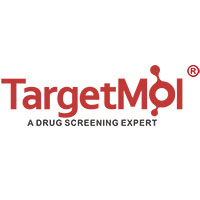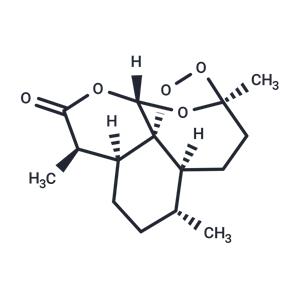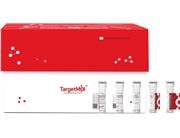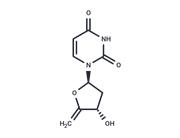| Name | Artemisinin |
| Description | Artemisinin (Qinghaosu) is a natural product, a sesquiterpene lactone, derived from Artemisia annua. Artemisinin has anti-malarial activity, as well as neuroprotective and anti-tumor activity. |
| Cell Research | Artemisinin is diluted in 0.01% DMSO. For this purpose, cells are cultivated in 96-well plates in DMEM, supplemented with insulin. The artemisinin, Dox, and DDP are added to media at different concentrations and the cells are cultivated for either 24 or 48 h. For this purpose artemisinin is diluted in 0.01% DMSO in media. After this time, 10 μL of the MTT dye solution (5 mg/mL in phosphate buffer saline) is added to the cells; the cells are incubated at the same conditions for 3 h. After centrifugation (1500 rpm, 5 min) the supernatant is removed. 100 μL of dimethyl sulfoxide is added to each well, to dissolve formazan. The absorption is measured, using a multi-well spectrophotometer at a wavelength of 540 nm. |
| Kinase Assay | Briefly, PC12 cells are lysed in lysis buffer and centrifuged at 12,500×g for 5 min 15 mL of cell lysate is incubated with 50 mL of 2X substrate working solution at room temperature for 30 min in 96-well plates. The fluorescence intensity is then determined by Infinite M200 PRO Multimode Microplate at an excitation wavelength of 490 nm and emission at 520 nm. The fluorescence intensity of each sample is normalized to the protein concentration of sample. All values of % caspase 3/7 activities are normalized to the control group. |
| In vitro | METHODS: A375 and Sk-Mel-28 cells were treated with Spautin-1 (2.5-20 µmol/L) for 24-72 h. Cell viability was determined by MTS assay.
RESULTS: Spautin-1 significantly reduced the proliferation of A375 and SK-Mel-28 in a dose- and time-dependent manner. 72 h IC50 values of Spautin-1 on A375 and SK-Mel-28 were 1.830 and 2.062 µmol/L, respectively.[1]
METHODS: K562 cells were treated with Imatinib mesylate (250 nM) for 12 h and Spautin-1 (10 µM) for 36 h. The expression levels of target proteins were detected by Western Blot.
RESULTS: The autophagy in K562 cells was activated by Imatinib mesylate treatment, and the autophagy in K562 cells induced by Imatinib mesylate was strongly inhibited by Spautin-1. Spautin-1 strongly inhibited autophagy induced by Imatinib mesylate. [2] |
| In vivo | METHODS: To investigate the therapeutic potential for acute pancreatitis, Spautin-1 (2 mg/kg) was intraperitoneally injected into KunMing mice with cerulein or L-arginine induced pancreatitis.
RESULTS: Spautin-1 effectively inhibited autophagic flux and ameliorated the pathogenesis of acute pancreatitis induced by cerulein or L-arginine. The effects of Spautin-1 in ameliorating acute pancreatitis were associated with impaired autophagic inhibition and alleviation of Ca2+ overload. [3]
METHODS: To investigate the effects on cognitive and memory deficits after traumatic brain injury (TBI), Spautin-1 (10 mmol/uL, 2 uL) was injected into the left ventricle.
RESULTS: Spautin-1 administration may attenuate mild TBI-induced cognitive and memory dysfunction in mice by activating caspase-3. [4] |
| Storage | Powder: -20°C for 3 years | In solvent: -80°C for 1 year | Shipping with blue ice. |
| Solubility Information | DMSO : 45 mg/mL (159.39 mM)
Ethanol : 21.2 mg/mL (75 mM)
|
| Keywords | Hepatitis C virus | Akt | NSC-369397 | Inhibitor | inhibit | Protein kinase B | HCV | PKB | Ferroptosis | NSC369397 | Artemisinin | Parasite |
| Related Compound Libraries | Bioactive Compound Library | Traditional Chinese Medicine Monomer Library | Kinase Inhibitor Library | Anti-Cancer Clinical Compound Library | Anti-Inflammatory Traditional Chinese Medicine Compound Library | FDA-Approved Kinase Inhibitor Library | Cosmetic Ingredient Compound Library | Anti-infective Natural Product Library | Bioactive Compounds Library Max | Anti-Cancer Drug Library |

 United States
United States



